

Syntax of Color. I want to highlight a website called Syntax of Color which aims to focus on Art Materials and Colour.
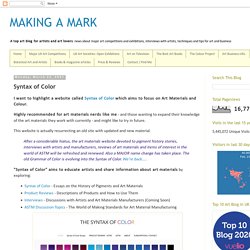
Highly recommended for art materials nerds like me - and those wanting to expand their knowledge of the art materials they work with currently - and might like to try in future. This website is actually resurrecting an old site with updated and new material. After a considerable hiatus, the art materials website devoted to pigment history stories, interviews with artists and manufacturers, reviews of art materials and items of interest in the world of ASTM will be refreshed and renewed.
Also a MAJOR name change has taken place. Botanical Plant Illustration – LinBi. A brief introduction to drawing trees Botanical illustration is a discipline of visual communication, based on artistic techniques whose main goal is to represent a plant in the most accurate way to display its essential features.
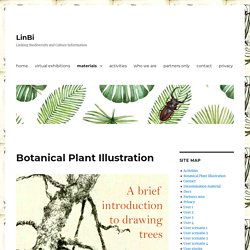
The library of the Real Jardín Botánico (RJB) has located, identified, described and organised a collection of more than 70,000 botanical illustrations, drawn from of a collection of our most valuable, ancient and special books. Various eras, artists, styles and printing techniques are well represented in this impressive botanical collection, which is now available on the internet. You can now locate these illustrations of plants and fungi via the main European digital heritage platform Europeana or via the RJB Digital Library website. We encourage you to explore and consult the digital collection of botanical illustration, to (re-)use the contents in projects of any kind which might benefit from such documentation.
Collected on this day in 1944 - Carnegie Museum of Natural History. By Mason Heberling Herbarium specimens are both an art and a science.
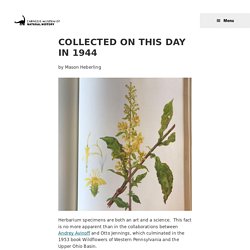
This fact is no more apparent than in the collaborations between Andrey Avinoff and Otto Jennings, which culminated in the 1953 book Wildflowers of Western Pennsylvania and the Upper Ohio Basin. Jennings was a longtime curator of botany, professor at University of Pittsburgh, and served many roles at the Carnegie Museum of Natural History (including director from 1945-1949). Avinoff was a lepidopterist (studied butterflies) and artist, who was Director of the Carnegie Museum if Natural History from 1926-1945. The book features a detailed, scientific manual describing plant species found in the region written by Jennings, along with 200 watercolor paintings of a subset of these species by Avinoff. Making Colors (7): Failure and Success in Historical Remaking - Jessie Wei-Hsuan Chen. *This blog post is part of the series Making Colors.
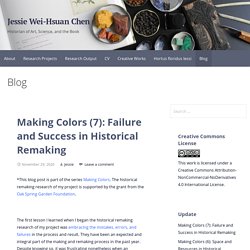
The historical remaking research of my project is supported by the grant from the Oak Spring Garden Foundation. The first lesson I learned when I began the historical remaking research of my project was embracing the mistakes, errors, and failures in the process and result. Woodblock of Imperatoria — Dumbarton Oaks. Utrecht University on Instagram: “Let's take a study break and paint with Jessie Wei-Hsuan Chen (@JessieWHChen)! Jessie is a PhD candidate at the Research Institute for…”
Stress-Relief Painting Tutorial by Jessie Wei-Hsuan [Well-being Week] Let's take a study break and paint with Jessie Wei-Hsuan Chen (@JessieWHChen)!

Jessie is a PhD candidate at the Research Institute for History and Art History (OGK) at Utrecht University. She is currently working on the project “Everlasting Flowers Between the Pages: Botanical Watercolors in the Seventeenth-Century Low Countries.” The research investigates the epistemic values of seventeenth-century watercolor flower books and their role in knowledge production in early modern Europe. A Woodblock’s Career in: Nuncius Volume 35 Issue 1 (2020) Jump to Content Jump to Main Navigation Jump to Content Jump to Main Navigation.
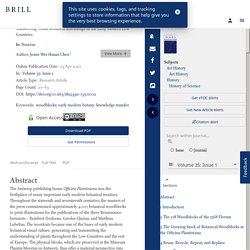
Paper: it’s not just made of trees! This 1999 Artists Book by Peter and Donna Thomas showcases paper samples made from such things as cattails, coconut husks, and pine needles □□ the Spanish moss paper is probably our favorite! Want to create you own species? Come and join us at the John Hope Gateway today and tomorrow 12-4for #FrankensteinsPlants. More info. Join botanical artist Bee Watson (@wildhivedesign) for an intro to the art of paper flower making. Learn to make your own detailed blooms, using high-grade Italian crepe paper at the #RHSLondon Spring Launch & Orchid Show. Book your place for 9-10 April. Science in hand: how art and craft can boost reproducibility. Even shaking a sample, rather than stirring it, can change results.
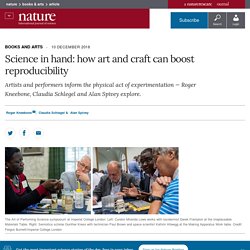
Why then, among the many reasons discussed for the reproducibility crisis, does lab practice not get more attention (see Nature 533, 452–454; 2016)? Most science students enter university with years of screen time under their belts, but very little experimental experience. Indeed, many early-stage PhD students struggle with the transition from predetermined practicals to independent experimentation and design, where the ability to notice tiny departures from the expected might be crucial to discovery. The act of drawing can teach more about Botanical morphology than writing. Elizabeth Yeats. Elizabeth Corbet Yeats (11 March 1868 – 16 January 1940), known as Lolly, was an Anglo-Irish educator and publisher.
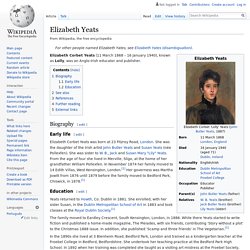
Biography[edit] Early life[edit] Elizabeth Corbet Yeats was born at 23 Fitzroy Road, London. Thinking Like A Plant.pdf. Botanical artist brings rare plants back to life. ‘Leaves of Burdock’, Joseph Mallord William Turner, c.1799-1800. Preserve Botanical Finds: Japanese Stationery. Did you go anywhere fun and inspiring this summer?
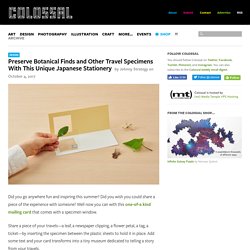
When Are Drawings Field Notes? - Field Book Project. By Lesley Parilla, Field Book Project I recently cataloged items from Smithsonian Archives RU 7186, United States Exploring Expedition Collection, 1838-1885, and came across a series of wonderful hand-drawn and hand-colored images.
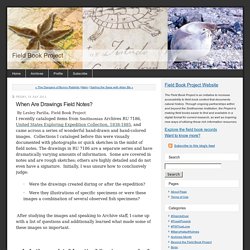
Rosemary Wise: Drawing Plants. Magic in a Packet: 1869 - BOTANICAL DRAWING - A How-To Series by Walter Hood Fitch. BOTANICAL DRAWING. -No. VI. Perhaps there are no flowers more varied in size form, and colour, than those of Orchids, and I think I may add more difficult to sketch, if the artist has not some general knowledge of their normal structure.
Dr. Color Our Collections: The Art of Intaglio Printing. This year for Color Our Collections, we've produced a coloring book with illustrations from books that represent the evolution of the art of printing. This week on our blog, we'll explore the books featured in the coloring book and the printing techniques used for the illustrations. You can download our 2017 Color Our Collections coloring book here. Learn more about Color Our Collections here. Coloring Our Collections: The Art of Lithography. This year for Color Our Collections, we've produced a coloring book with illustrations from books that represent the evolution of the art of printing. This week on our blog, we'll explore the books featured in the coloring book and the printing techniques used for the illustrations.
You can download our 2017 Color Our Collections coloring book here. Learn more about Color Our Collections here. Color Our Collections. The sublime and the tragic. As my collection for the London show at Abbott and Holder grows so does the initial idea. I guess this is what happens. In order to make good art you have to evolve with it. Art is not static, not even when it is 'finished' is it static. Finding Artistic Inspiration in Biodiversity Literature. It's no surprise that the natural history books and archives available in the BHL collection are of vital importance to scientists and modern scientific research. They not only provide species and habitat information, sometimes representing the only available knowledge for rare, endangered, and extinct species, but also help scientists identify new species, inform holistic conservation efforts, and provide the foundations upon which current scientific models are based.
Science is not the only discipline that makes use of BHL's collections. Historians and psychologists, for example, find invaluable information within the pages of historic biodiversity literature. Artists, too, uncover bountiful creative inspiration within BHL's 45+ million pages. Within natural history publications are millions of stunning images, ranging from simple woodcuts to elaborately hand-colored engravings, chromolithographed plates, and photographs. Werner’s Nomenclature of Colours. The Book That Colored Charles Darwin’s World.
“I had been struck by the beautiful colour of the sea when seen through the chinks of a straw hat,” Charles Darwin wrote, in late March, 1832, as H.M.S. Colour Wheels, Charts, and Tables Through History.